Reading the
Cards in Context
Mouse—This symbol denotes poverty caused through lack of initiative.
Do not wait for the opportunity to come to you—go out and seek it.
Near the “house” a mouse foretells loss through theft.
—The Complete Book of Fortune, on “Reading the Tea-Leaves,” 1936
The Lenormand cards are taken as pieces of an alphabet, and we build them up into words and sentences to generate meaning. It is important to learn the cards as a separate language. In this chapter we will take a look at the basics of the Lenormand language to see how cards are modified by the cards near to them and their location in a layout. This approach to reading in context and combination may have been inspired by tea leaf or coffee grounds reading, and those in turn through far more ancient meanings ascribed to objects for divinatory purposes, including dream interpretation and oracular utterances.
Some of these exercises and methods of reading the cards are not used by every reader, so you should try out as many of them as possible to see what really works for you to
unlock the cards’ meanings. You may find you have a particular skill or understanding in one of these areas, just as you might in learning a foreign language.
Order of Reading
There are three ways in which you can read Lenormand cards when laying them out in a row of two or more cards. They are:
- Blended/Merged
- Linear/Left to Right
- Affected by Following/Right to Left
If we take a simple two-card example of the Clover and the Fish, we can see how these orders take effect. The most important thing is to choose which method works best for you in different circumstances.

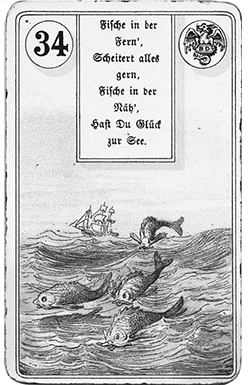
Figure 56. The Clover and the Fish
If we blend these two cards together, we generate a lucky fish, perhaps a talisman of good luck. There is a lucky event of some description with regard to our finances and resources, our general material well-being.
If, however, we read these cards in a linear left-to-right sequence like a storyboard, we would say, “First the Clover, then the Fish.” That is to suggest that we will have some lucky event that will bring more material benefits thereafter, good resources or work. The lucky event itself—the clover—may have nothing to do directly with what follows; it could even be something like a marriage, which brings financial reward in its own way!
When instead reading from right to left, in effect, we consider that the first card is the object (and this is usually, as it is the nearest card to our significator, or the significator itself, in reading lines in a Grand Tableau) and the following cards each have a roll-back effect on the cards preceding them.
In the simple case of the Clover and the Fish, it is the lucky event that is the object, and the Fish (resources) is applying to it. That might indicate more precisely that the nature of the lucky event will be one of resources—a winning lottery ticket, the finding of a lost wallet that brings reward, and so on.
When this applies to longer sequences, each card modifies the card before it, so the final card in a row is the most influential; it really tells us the most likely outcome and the general deciding factor. A long sequence of generally negative cards that ends in the Star may indicate that our hopes will ultimately be realised through struggle, whilst a sequence of generally positive cards culminating in the Mountain would suggest that we will face obstacles throughout the situation with little absolute result—just another obstacle.
Negative and Positive Cards
Whilst every card in Lenormand is influenced by its position and context, unlike tarot where most cards are given a positive aspect (e.g., the Tower is not just disruption, it is clearing the air to see new horizons), some cards in Lenormand are generally negative, such as the Snake.
You might like to read the instructions for the Game of Hope given in the appendix to this book to see which cards set you back and which cards move you forward in the game. It was definitely the case that some cards were favourable and others unfavourable.
There are other cards that might be considered more neutral, such as the Clouds, which are affected by their facing. These cards also show a lack of clarity or confusion, which is neither good nor bad, although it again depends on the surrounding cards.
Exercise: Near and Far
First, we’re going to play a game of “near and far,” or “hot and cold.” This will make sense as we approach the Grand Tableau method later and instill a good habit in reading Lenormand, where combination and context is so very important to interpretation.
It is a simple game based on Japanese grammar, where the distance of an object changes the very word you use to speak about it. We think this is unique to Japanese, and it is very useful to learning the language of the Lenormand.
Imagine a bear. You are looking at it on a screen or from a considerable distance, separated by something. What comes to mind? The bear’s movements, perhaps the way it shambles? Make a note in the table below the words that come to mind, “shambling” or “strolling.”
Now imagine the bear in the room with you, or very close up! What comes to mind? Other than “Run!”? Perhaps “strength,” “power,” or “fear.” Write that in the other box below.
Then you can repeat the exercise with the following selection of cards:
|
OBJECT |
FAR |
NEAR |
|
BEAR |
Slow movement, strolling |
Roar, power, fear |
|
TREE |
||
|
MOON |
||
|
GARDEN |
||
|
MOUNTAINS |
||
|
HEART |
||
|
GENTLEMAN |
If you are journaling your discovery of the Lenormand cards, you can of course do this with all the cards to discover your own interpretation of objects near and far to you. It can also be instructive to go back over your keywords and kaleidoscope words and plug them into the near/far table to consider how, for example, the Mice (choosing a keyword such as “disruption”) would work under your nose and at a distance. After a while, you can practice near and far with combinations, such as for a question about a sales job. Mice and Bouquet near to you might signify self-doubt if the cards were close at hand (Mice as worrying, Bouquet as self-appreciation in this case), or someone giving you false leads if the two cards were at a distance (an apparent gift like flowers, but something that actually gnaws away at your foundations, the mice).
We will now introduce you to the relative significance of cards depending on their position in what is called the Grand Tableau. We will do this by playing a game we call Le Tableau Vivant or “living picture.”
The word tableau means both “table” and “picture,” so it is a wonderful word for our grand spread.
The Grand Tableau
There are many ways to read Lenormand cards, however, unlike tarot they rarely depend on a fixed positional meaning. That is to say, there are not (yet) whole books of spreads where for example the card in position 3 indicates the sitter’s hopes or the card in position 9 represents how others see them.
Lenormand cards are read usually in lines (linear Lenormand), curves (horseshoes), circles, or in tableau, usually laid out in a block. We are going to start in the deep end and look at the tableau; it is the best way to teach the cards in relationship to their relative positions.
So, let’s scare ourselves un petit peut first by seeing what we will end up being able to read when we have finished. Take a deep breath, and …
Now, whilst that may seem a little scary—all thirty-six cards laid out with not a positional meaning to read—that’s only because most of us are tarot readers or entirely new to cartomancy.
Before we go ahead and learn some practices so we can develop our skills, and then return to apply them to this method, just a few words about the Tableau.
There are several ways of laying this out. The two most widely used are the 9 x 4 (nine columns in four rows) or the 8 x 4 + 4 (eight columns in four rows with a fourth row of four cards below). We will use the 9 x 4 for this lesson and return to the other method later, as at present we are only interested in relative positions. We hope you did your “near and far” exercise earlier, as it will help you now.
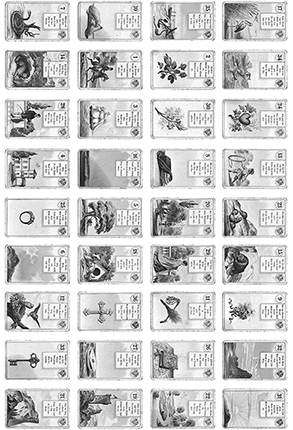
Figure 57. The Grand Tableau
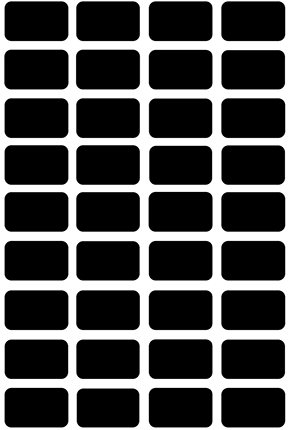
Figure 58. Grand Tableaux 9 x 4
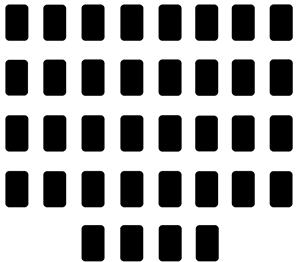
Figure 59. Grand Tableaux 8 x 4 + 4
Cherchez la Femme
The clichéd phrase cherchez la femme actually first appears in a novel by Alexandre Dumas set in Paris whose crime inspector regularly uses the phrase, as often the key to any investigation is a woman! So it is fitting we start to investigate our tableaux and relationships by playing a little “search the woman.” In Lenormand, the sitter is represented by either of two cards, the Gentleman or the Lady, as befits their stated gender. We will see later how we can charge the cards and ask the Lenormand questions for a specific purpose, situation, or issue, using key cards such as the Bear for questions of health, for example. For now, we will start with the Gentleman and the Lady.
In most decks, these cards face particular directions, so we can see how they are “looking forward” or “leaving behind” other cards, for a start. How cool is that?
One way of reading is to presume that what is to the left of the sitter’s significator (Gentleman or Lady) is the past, and what is to the right is the future.
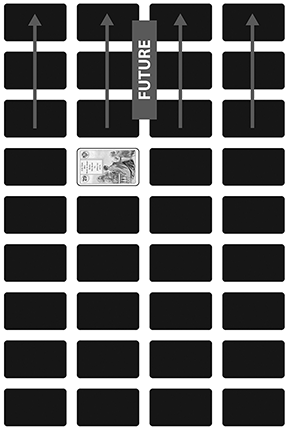
Figure 60. Determining Past and Future
Time Issues in L-Space
As an important side note, we should here explain that L-space is very different, yet somewhat similar, to T-space. This is what makes it tricky. We must remember that a lot of what we know as tarot methods derive in part from the Golden Dawn era, where counting cards, dignities, and all manner of esoterica was introduced. The Golden Dawn itself was basing their correspondences on their reading of earlier cartomantic methods, with an added Industrial-Kabbalah flair. So when we look at Lenormand (and not that much is known as to how the cards were actually read) and the cartomantic methods of the time, we see a lot of echoes, people using the same ideas, that later come back up on the other side of the Golden Dawn synthesis into popular T-space. It can be mind-bending.
The question is simply “where is past and future in a reading?” particularly when we use the Grand Tableau. As ever, there is no “right” answer, just a preferred methodology. We’ll give some background that may help you make a decision—which you are free to later change after practice!
Early card-reading books have sections called, for example “Look to your right, and to the left of the consultant” (this from an 1872 book), which is quite fascinating because they are not related to time, but to influence. Certain cards one side of the consultants card mean one thing, and to the other, something else. The books are usually written in such a way as to reveal certain patterns, e.g., “should there be two aces, it indicates you have enemies” but not provide a totally comprehensive scheme or teaching.
They certainly tend to a “right to left” linear reading style that combines cards with no fixed idea of past and future, just a “fortunetelling” presentation: “I perceive that you have a suitor who is dark-complexioned, and this will result in an argument between two women, and your sister will come to no good.”
A more recent compilation in 1903 reveals a simple past-present-future spread by dividing a playing card deck into three piles, reading the pile to the left being the past, the middle present, and the right being the future.
In the Golden Dawn, in the Celtic Cross positions for past and future—in the original method, using Golden Dawn court cards as signficators, which faced one way or another—the querent card faced the future and had its back to the past, meaning that things depended on the direction of facing of the court card. This got horribly confused when Waite published the method as “another method of divination” in his own book accompanying the deck he created with Pamela Colman-Smith, where the court cards do not necessarily face one direction or another. It has led to a century of silliness about which side is past and future in the Celtic Cross.
In the real world, as we might deduce from neuro-linguistic programming (NLP), people are found to have different notions of time-space. One of our Tarosophy methods asks people to think about their past and future by asking questions such as “did you find it easy to get here this morning” or “where are you going to be for the holidays” and watching eye movements to naturally discern how the querent represents time. We then lay out a freeform spread based on his or her own unconscious representation.
It is sometimes a straight line (where people get the idea of a timeline), and often left-right/back-forwards. All sorts of shapes are possible, however, say for example with bad memories being held in a quarantine zone far away from the timeline.
Anyhow, the gist of it is that there’s no single right way. If we stick with tradition, we tend to use the direction the sitter’s card is facing to denote the future and what is “behind” them to denote the past. We do not think that a Grand Tableau has little about the “future” just because the sitter’s card is right on the left, facing the edge. All it means is that everything about their potential and future is to be discerned from what is behind them. Such is often the case in life.
Think of it like a tiller on a ship. We may navigate to what we see ahead, but our direction is made by where the tiller behind us is positioned. The trick is to have both navigator and steersman working together—and the Grand Tableau (hereafter GT) can let us see this, no matter where the sitter’s card is positioned.
We need to move from T-space to L-space in this context, where the whole GT tells us about both past and future, even if it presents only what is before or behind the sitter. In doing so, when we return to T-space, we may even bring a new perspective to our tarot readings.
Now let’s add the Gentleman card, and assume that we are looking at a situation about a relationship—which we know will be three in five questions asked of us in the salon.
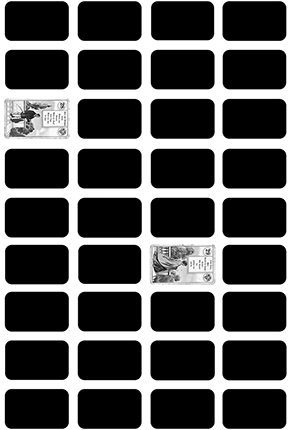
Figure 61. The Gentleman and the Lady
Here we see that the man is having to look up to the woman, who in turn looks away from him. The man sees the woman in his future, however the woman cannot see the man in hers. This can be read as literally as it appears, if you wish.
We can already see, we hope, that we need more cards to clarify this situation, and that is a big difference between Lenormand and tarot readings—the more cards, the easier it actually gets to read once a few basic skills are under our belt and we have practiced our methods.
Let’s now have a bit of a refresher of a few cards so we can use them to create our own life maps.
The Gentleman
When the sitter is male, this card relates to them; when the sitter is female, this card relates to their significant other, such as a romantic interest, or a male figure in their work/social/home life generally.
The card also indicates in a general sense a certain formality, an adherence to social expectations and at worst, a somewhat aggressive dominance in the situation. The card at best shows cultivation and careful attention.
The Lady
When the sitter is female, this card relates to them; when the sitter is male, this card relates to their significant other, such as a romantic interest, or a female figure in their work/social/home life generally.
Again, the card shows a certain formality, yet perhaps not so much as the Gentleman card. It relates to the Ace of Spades in cartomancy, and in the earliest known publication listing meanings for cards, we have this:
You that draw the Ace of Spades,
Shall be flouted by the maids;
When it is a damsel’s lot,
Wit and humor go to pot.
—Dr. Flamstead’s and Mr. Partridge’s New Fortune-Book, 1710
An 1872 book on fortunetelling in our library gives the Ace of Spades as also signifying love and relationships, matters of the heart (where one might expect these to apply to the Ace of Hearts), and when reversed, the Ace of Spades signifies pregnancy, maternity, and conception.
Having looked at the main characters of the Lady and Gentleman, we’ll look at the Heart, Cross, and Ship cards to build a basic relationship reading between this pair.
The Heart
The keyword for this card is courage. In a relationship query it signifies being true to your own heart and having the courage to express your feelings to a significant other. People often speak of not having “the heart” to tell somebody something, in case it results in hurt feelings; the sitter in question may have to bite the proverbial bullet and speak the unspeakable.
This card also signifies “goodness” and virtue, being authentic and true to oneself.
The Cross
The keyword for this card is faith; this card signifies a state of keeping faith, whether it is in relation to a romantic endeavour or the sitter being able to keep true to his or her own true intent. However, as not all acts of faith turn out to have a favourable outcome, this card can also signify a burden that may have to be carried before there is any resolution.
It can be the sign that a belief, for example, is limiting or outworn, depending on the cards about it and its relationship to all other cards, as we will come to see.
The Ship
The keyword for this card is adventure. In a reading, it can signify a longing to break free from the life presently lived, and to find success and opportunity on new horizons. This card is effectively a calling card for transition.
Its position in a reading shows where movement is possible, despite any obstacles indicated by the cards around it. It is the go-to card for showing where choice may still be found and one’s own course plotted in a given situation.
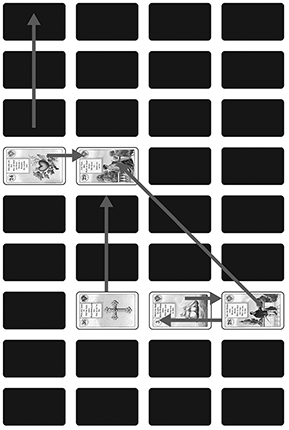
Figure 62. Cards in Relationship
Now let’s take a look at these cards in relationship to one another. It is very important to look at the relationships and positions of the cards relative to each other, and in each case, in both directions. What appears above can influence what appears below.
In a later chapter, we will cover “knighting” movements and other more complex arrangements and patterns; here we can simply look at our first obvious layer of straight lines and a little bit of diagonal. As they say, that’s “something racy for the gulls” (a little bit of extra for those who look for it)!
The woman looks away into the future, but the man is not there. The heart of the matter belongs to her—it is closer to her. If you did the “near and far” exercise, you might interpret that her heart is too close to her, that she wears it on her sleeve. It is also above her, perhaps indicating that she is ruled by it, and easily—there is no deep consideration, just emotional response.
We can see too in her past (to her left) is the Cross, indicating something interesting—perhaps there was a loss of faith in her past and she’s moving away from it. We know this only because of the overall picture; there is nothing in that particular card that explicitly indicates faith or the loss thereof—it just makes sense in the overall context.
We think that is a good example of how our ability as “sense makers” and storytellers works to interpret Lenormand against the more structured and sometimes singular patterns of tarot.
What about our man, the sitter in this particular example? He has to look up to the woman—perhaps indicating a certain idolisation from afar. It is possible he has not even spoken to her yet. This is probably the question—“What will happen if I speak to Danielle?” Often in Lenormand it is better to have an exact question because it provides context for the interpretation.
He is also below the Ship, showing that it is at the same time providing him clear access and freedom, yet it is overweighing him because it is right on top of him—he is spending too much time thinking about something that he is totally free to do. Again, we look up further and see that same Cross card—he has a big issue with his faith in himself and his own freedom (Ship).
And here’s the nice thing—the man and the woman share that Cross in common, though in different ways. If we were to offer advice from this reading, it would be to approach Danielle with the spirit of a shared doubt—one she has recently experienced, and one with which he himself struggles.
There is a saying in alchemy: “through the cross to the rose.” Here we may see that saying play out in a real-world relationship. Are you interested in seeing all the other cards now so we might read even more? Well, not yet … let’s practice!
We will give you three vignettes, like short stories. We’d like you to lay out the five cards we have used above (Gentleman, Lady, Ship, Cross, Heart) to illustrate the vignette. In this way, we break the usual way of teaching cards, by applying real-life to the tableaux first. We talk to the Lenormand, it will talk to us.
Don’t forget, these must be laid out within a 9 x 4 grid. Place each card where you think it would best suit the vignette.
You can also optionally add any one card from the Lenormand deck to help you illustrate each vignette.
Exercise: Mary et John
Mary is married to John and they are talking about their future. They want to share it together, yet they struggle because John has a gambling issue. Their house is now at risk and he has started drinking. Mary is at her wit’s end and cannot see any future.
Exercise: James et Cristobel
Let me tell you about the budding relationship that is unable to progress forward for James and Cristobel. James is in a quandary; he is in a relationship with a special woman. However all is not ideal, as they live thousands of miles apart, he in London, and she in Sydney, Australia. He has just received a letter from Cristobel, who is sick of being in a long-distance relationship. She has written asking him to move to Sydney to live with her. (She likes old fashioned letter-writing for affairs of the heart!) He is loathe to do this, however, because he has built a successful business in London, and all his family and friends live there. James does not know if he can take the risk and move to Sydney to be with Cristobel. Despite how much faith he has in the relationship so far, he does not feel brave enough to do this—after all, there’s no guarantee that things will work out. He knows he needs to resolve the situation soon, but James cannot bring himself to talk to Cristobel about his feelings in case he upsets her, creating a distance between them in more than geography alone, as Cristobel is feeling increasingly rejected.
Don’t forget too that the relationship and distances between cards can describe the strength or weakness of feelings, whilst their position above and below each other shows dominating or conscious influences over lower (in control or unconscious) influences. The tableau should always come together as a whole, like a jigsaw puzzle.
Exercise: Alan
In this vignette, we have only Alan as our sitter; no woman is involved, so the Lady card here stands for intuition and emotional response.
Alan is a businessman and has a long history of success. However, he has recently been made redundant from his company and is at a bit of a loss. He wants to travel but feels he needs his security and should find another job as soon as possible. He has no time for his own emotional life and just wants a logical way to make the right decision.
How would you describe this situation in terms of a tableau?
In this section, we have seen how the cards speak langue Lenormand by being in context with each other, and how combinations of cards can be given particular meaning depending on their position and relationship. We will start to weave this together in the next section, looking more at the whole Grand Tableau.
Saboteurs and Silhouettes
In these optional exercises, we’ll give you a bridge to the next lesson and also something you can apply to other styles of Lenormand reading outside this introductory book.
When we look at combinations of cards for linear readings and horseshoe readings where we can pair cards together (much as the Golden Dawn did in their Opening of the Key spread) we can come up with meanings for pairs of cards. However, these “flip” depending on which card we present first.
We have given below some of our own personal meanings, both directions—saboteur and silhouette—and you can complete the missing pairs and create your own if you wish. A “saboteur” is a card which works to influence the first card without being recognised itself. It may also provide a “silhouette” in that it provides an outline or framework in which the first card comes to life.
- The Rider/Messenger + Clover = Wisdom begins by knowing oneself. [The Clover to us is about “identity” as much as “luck”]
- Clover Leaf + Rider/Messenger = Sense of self awaiting validation
from another.
Here the silhouette reading is changed because we have the Rider following the first card, meaning there is still some delay in the manifestation of the first card, here the “sense of self” or identity.
- Ship + House = Speculating wisely for the future
House + Ship = Living for today in case there is no tomorrow - Tree + Clouds = Midlife crisis looming
Clouds + Tree = Transitory resources - Snake + Coffin = Spiritual emergency
Coffin + Snake = - Bouquet + Scythe = Appreciation brings change
Scythe + Bouquet = - Whip + Birds = Working toward revelation
Birds + Whip = - Child + Fox = White lies and cunning behaviour
Fox + Child = - Bear + Stars = Aggressive behaviour creating bad energy
Stars + Bear = - Stork + Dog = Expect questions over loyalty to be brought up
Dog + Stork = - Tower + Garden = Imagination creates good company
Garden + Tower = - Mountain + Ways =
Ways + Mountain =
Don’t forget that you can go back to the list of single keywords and the keyword kaleidoscope to help you create your own combinations for these cards. Then, see what happens as you consider them each in opposite order of presentation. Lenormand is all about patterns and the big picture.
Reading Cards in Any Context
Generally speaking, questions will always focus on one particular area, be it someone’s relationship, career, finances, health, travel, lifestyle, and occasionally education and legal issues. In this section we will show how two selected cards can be taken in each of these areas, by themselves or in combination with a number of other cards in sequence.
The Rider in the Context of Work
The Rider card is symbolic of the delivery of communication in many forms, either through the physical delivery of news via the postman or verbal communications in day to day conversation. It can signify the delivery of gossip, where we are reminded of the old saying “don’t shoot the messenger.”
This card is the effective relaying of communication across various networks. It can also be the phone call you receive, the email, or the text message. News good or bad is delivered a lot swifter these days than via the old-style horseback messenger.
The appearance of this card in the context of work puts a great emphasis on effective communications, making sure the person who needs to get the message gets it loud and clear. The person who needs to get the message could be the one in the office who never listens to what you say. So the Rider can stress the importance of delivering your ideas with clarity.
The meaning of the card of course changes by the influence it takes on from those cards around it. The Rider with the Whip may say “news is troubling,” which could be news about unpaid overtime or a form of servitude; you may feel you are being taken advantage of at work. The Whip can be about trouble and strife in your life.
Switched Sequence
- Whip + Rider may say “trouble delivering news.” It also may
imply trouble getting something across, itself causing strife in a
work environment.
Rider in the Context of Finances
- Rider + Whip + Fish = News is troubling regarding money
Switched Sequence
- Fish + Whip + Rider = Money trouble news
Rider in the Context of Health
- Rider + Whip + Coffin = News of troubling illness
Switched sequence
- Coffin + Whip + Rider = Illness that is troubling news on the way
Rider in the Context of Relationships
- Rider + Tree = News of family
Switched Sequence
- Tree + Rider = Family news to come
- Rider + Heart + Gentleman or Lady + Clover = News of
love from Gentleman or Lady will bring luck (well-being)
Switched sequence
- Clover + Lady or Gentleman + Heart + Rider = Luck (well-being) at finding Lady or Gentleman for love and possible marriage as dating agency delivers match.
- Rider + Whip + Heart + Mice = Gossip delivered (news) brings strife, gnawing away at you.
Switched Sequence
- Mice + Heart + Whip + Rider = Gnawing feeling that strife will result from gossip in future (news)
Rider in the context of travel and lifestyle
- Rider + Ship = Postman delivers travel tickets
Switched Sequence
- Ship + Rider = Holiday travel tickets on their way
The Fox in the context of work
As mentioned earlier, the Fox is the (somewhat opportunistic) entrepreneur of the Lenormand deck. Remember, however, that this card is not all bad—if you put the Fox with Clover, for example, it could say you will have innovative ideas that make you lucky. As with most divination, there is no “good” or “bad,” it’s all in how we read it.
- Fox + Garden = Crafty behaviour expected at a conference
Switched sequence
- Garden + Fox = An innovative conference
Three Cards with the Fox
- Fox + Garden + Tower = Crafty behaviour during a conference—
watch out for yourself
Switched sequence
- Tower + Garden + Fox = Be on watch at the conference for crafty behaviour/sly tricks
Below we have added Clover to the sequence, which modifies the meaning, putting a more positive slant on the interpretation. Every Lenormand cloud has a silver lining, which is why it is so important to read cards in combination. Otherwise it’s akin to tearing the last page out of a novel and never having the full story.
Four Cards with the Fox
- Fox + Garden + Tower + Clover = Watching out at the conference
for crafty behaviour/sly tricks could prove advantageous.
Having introduced ourselves to these sequences and combinations, as well as the general layout of the Grand Tableau, we will now move on to the GT itself. You may feel you need a G & T to tackle it, however, we are now reasonably prepared!